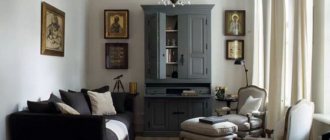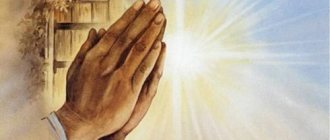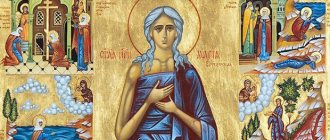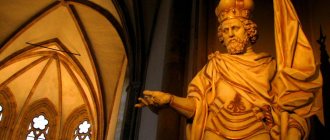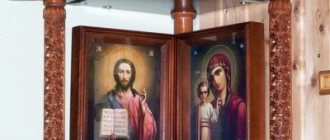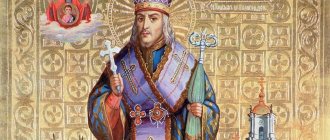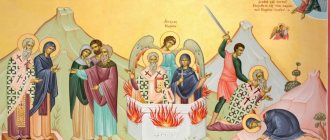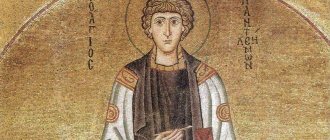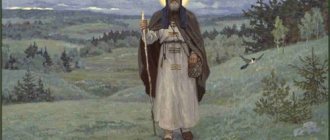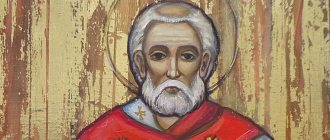Medieval Renaissance icon painter
The name of Theophanes the Greek is in the first rank of ancient Russian icon painters; his outstanding talent was already recognized by his contemporaries, calling him “a very cunning philosopher,” that is, very skillful. He made a huge impression not only with his works, but also as a bright personality.
Unfortunately, the dates of the artist’s life are unknown. Presumably they fall on 1340–1410. From the Byzantine Empire, Theophanes arrived in Rus' as an already established master. We learn about this from a letter from Epiphanius the Wise, an ancient Russian writer and disciple of St. Sergius of Radonezh, to Cyril, Archimandrite of the Tver Spaso-Afanasyevsky Monastery. Epiphanius reports that Theophanes painted forty churches in Constantinople, Galata (a suburb of Constantinople), Kafa (a city in the Crimea, modern Feodosia) and other cities. In Rus', as Epiphanius writes, the Greek worked in Veliky Novgorod, Nizhny Novgorod, Pereslavl-Zalessky, Kolomna and Moscow.
What is surprising is not only the manner of Theophanes the Greek (which will be discussed below), but also his very personality. Frescoes and icons give an idea of him as an outstanding artist and representative of hesychasm. But, as Epiphanius the Wise notes, the Byzantine master was an extraordinary personality, he painted freely, regardless of samples, preached from the scaffolding, and wittily answered questions from people who came in crowds to the cathedral, where he painted frescoes. Epiphanius describes the Greek as we would describe the masters of the Renaissance. But, apparently, this was Feofan, a Byzantine master who left his bright mark on ancient Russian art.
Faith and beliefs of Theophanes the Greek
By the time of his arrival in Rus', Feofan was already inspired by the mystical teaching known as hesychasm. The word “hesychasm” comes from the Greek hesychia - “calmness”, “silence”, “detachment”. This teaching was formed in the early Byzantine era, and it could only be found in monasteries. However, in the 14th century, the teaching went beyond their limits, received theoretical justification and became accessible to the laity. Hesychasm taught that the Word of God is comprehended in silence. Refusal of verbosity, comprehension of the Word in its very depth and contemplative prayer will lead to the path of knowing God. But the main meaning of hesychasm is not the highest prayer - it was comprehended through spiritual practice and consisted of an absolute spiritual transformation, transfiguration. It is no coincidence that Theophan owns the icon of the Transfiguration of the Lord. The Tabor light, which the apostles saw during the Transfiguration of the Lord Jesus Christ, was of great importance for hesychast practice. This light, as the hesychasts said, is the inner light of transformation. “The Kingdom of God is within man” - Theophanes the Greek clearly embodies this idea in the manner of his painting. Feofan was not just a religious man, but even a deeply convinced man of the importance of spiritual strength, faith and activity, especially in the country in which he lived. And the character of the great painter matches it - tough, ascetic, reflective. Researchers note that Theophanes the Greek is characterized by a denial of optimism. He admits that man is initially sinful, therefore he can only wait with fear and humility for the decision of his fate at the Last Judgment. And these beliefs well reflect the techniques of his work.
"Our God is a consuming fire"
Feofan’s first work is considered to be the painting of the Church of the Transfiguration on Ilyin Street in Novgorod. It is mentioned in the Third Novgorod Chronicle: “In the summer of 6886 (1378 A.D.) the Church of the Lord God and our Savior Jesus Christ was signed in the name of the magnificent Transfiguration…. And it was signed by the Greek master Feofan.” Unfortunately, the painting has not been completely preserved, but even in this form it amazes with its amazing artistic skill and freedom. And the originality of the images testifies to the author’s familiarity with the teachings of the hesychasts, mystic monks, whose spiritual practice was based on the contemplation of the uncreated Tabor light.
Church of the Transfiguration on Ilyin Street, Veliky Novgorod. Author: Alaexis - Own work, CC BY-SA 2.5, Link
Crossing the threshold of a small but elongated temple, you find yourself literally before the fiery gaze of Christ the Pantocrator, depicted in the dome: lightning seems to sparkle from His wide-open eyes. A powerful image dominates the space of the temple and makes us remember the words from Holy Scripture: Our God is a consuming fire (Heb 12:29 ) or I came to bring down fire on the earth (Luke 12:49 ). Feofan’s pictorial language is built on this - the master uses only two colors - ocher and white, and paints with great expression. On an ocher background (the color of the earth), lightning flashes of white light flash - this is an image of divine energies that pierce the flesh of the world, burn all untruth, dividing creation into light and darkness, heavenly and earthly, spiritual and mental, created and uncreated.
Theophanes the Greek. Christ the Pantocrator. Author: Vash Alex kun, Link
Researchers argue about the unusual color scheme of the painting. They put forward a version about a fire that discolored the painting. But archaeologists found no traces of the fire, and restorers confirmed that the paint layer was like this originally. And the figurative structure of Feofanov’s painting suggests that this is a metaphorical language that conveys the action of divine energies.
Theophanes the Greek. Elijah the Prophet. Fresco by Theophanes the Greek. Church of the Transfiguration, Veliky Novgorod
Unfortunately, the painting has not been preserved in its entirety: there are small fragments in the apse and on the walls of the temple. The dome part turned out to be the most preserved. In the dome, Christ the Pantocrator is surrounded by angelic forces. An inscription from the psalm runs around the circle: “Lord, look from heaven to earth to hear the sighs of the chained (prisoners. - Ed.) and to release the sons of the slain (to allow the sons of death. - Ed.), so that the name of the Lord may be preached in Zion (Ps 101 :20-21).” The drum represents the forefathers Adam, Abel, Seth, Enoch, Noah, Melchizedek and the prophets Elijah and John the Baptist. Here the theme of light-fire continues: if the first world perished from water, the second will perish from fire, but the ark in the hands of Noah is a prototype of the Church. The prophets Elijah and John the Baptist symbolize the connection between the Old and New Testaments, these are fiery prophets: Elijah brought down divine fire from heaven onto a sacrifice and was himself taken on a fiery chariot to heaven (2 Kings 1-2 ), and John the Baptist baptized the people in water and proclaimed that Christ would baptize with the Holy Spirit and fire (Matthew 3:11 ).
Illuminated on the stone
The most unusual thing in the Church of the Transfiguration are the paintings of the so-called Trinity Chamber - a small room in the choir intended for individual prayer. On the eastern wall there is an image of the Trinity (“Hospitality of Abraham”): Abraham and Sarah not so much receive as they contemplate three Angels sitting around the sacrificial meal. The figures are painted in ocher, and white paint indicates semantic accents - the outlines of halos, highlights on the wings, staves with trefoils at the end, toroki rumors (ribbons) in the hair, flashes of light on the faces and in the eyes. The bright white strokes in the eyes of the Angels make us recall an image from the Apocalypse: His eyes are like a flame of fire (Rev 1:14 ). The image of three angels is shown as a luminous phenomenon.
Theophanes the Greek. The Holy Trinity. Fresco of the Church of the Transfiguration on Ilyin Street, Veliky Novgorod
Along the walls of the chamber, on three sides, there are depictions of stylites and hermits standing in prayer to the Holy Trinity. In these images, the dichotomy of Feofanovsky coloring acquires special strength and tension. The activity of white color increases from image to image.
Daniel the Stylite. Feofan the Greek, Link
The Venerable Daniel the Stylite appears with his hands extended forward, on the tips of his fingers there are energetic strokes of white - he seems to be touching the light, feeling it physically. The light slides in free streams over his clothes, pulsates on the curls of his hair, and is reflected in his eyes. The Monk Simeon of Divnogorsk, with his arms spread to the sides, receives the stream of light descending on him. The light reflections on his clothes resemble sharp lightning bolts piercing his body like arrows. There are no pupils in the open eyes, light is depicted in the eye sockets - the saint contemplates God, is filled with uncreated light. The Monk Alypius the Stylite has his hands folded on his chest, his eyes are closed, he listens to his heart, as the hesychasts advised: “Lower your mind into your heart and then pray.”
Macarius of Egypt. Feofan the Greek, Link
And, finally, the image of the Monk Macarius of Egypt: the elongated figure of the ascetic is completely engulfed in light, like a white flame. He is the only one depicted not on a pillar, he himself is like a pillar of light. On the white figure, the face and hands painted in ocher stand out, put forward with palms open outward. This is a posture of acceptance of grace, openness to God. The light shines on the face, but the eyes are not written at all, because the saint does not need bodily eyes, he sees God with his inner (spiritual) gaze, he does not look at the external world, he is all inside. The Monk Macarius lives in the Light, he himself is this Light, like the Apostle Paul: It is no longer I who live, but Christ lives in me (Gal 2:20 ). Macarius of Egypt is an image of exceptional power that has no analogues either in Byzantine or ancient Russian art. This is a vivid illustration of the hesychast mystical experience: the ascetic, in the process of communion with God, is immersed in the Light, in the Divine reality, but at the same time does not dissolve in it like salt in water (as, for example, Eastern religions teach), but retains his personality, which is purified and transforms. Hesychasts called this theosis (Greek), deification.
Favorsky light
If the Novgorod painting has documentary evidence of the authorship of Theophanes the Greek, then the same cannot be said about the icons. In ancient times, authors did not sign their works. Nevertheless, several icons are associated with the name of Theophanes. One of them is “Transfiguration” from Pereslavl-Zalessky. Nowadays it is in the Tretyakov Gallery, and previously it was a temple image of the Transfiguration Cathedral in Pereslavl-Zalessky. The icon is large (184x134), monumental. The bright and original nature of the painting is similar to Feofanov’s style: the same temperament, the same fiery sound of light, the same expressive manner of painting. But there are also differences. Firstly, the icon is polychrome; here the master fully follows tradition. Secondly, the character of the image of the Savior is different: the face is not formidable, as in the Novgorod frescoes, but merciful, his features are softened, his gaze is attentive and meek.
Icon of the Transfiguration of the Lord. Feofan the Greek -
The composition of the icon is elongated vertically: Christ stands on the top of the mountain, and the disciples fell to the ground in fear and trembling. The Savior is surrounded by a radiance of glory, golden rays emanate from Him, the light pulsates with bluish reflections on the hills, on the trees, on the clothes. The light also penetrates deep, exploding everything from the inside, so that traditional caves on the coaster look like explosion craters. The Miracle of Transfiguration is shown as a cosmic event that turns the universe upside down, transforming all creation.
Next to the Savior stand the prophets Moses and Elijah, personifying the fullness of the Old Testament (“Law and Prophets”) and the fulfillment of all aspirations and prophecies in Christ. The presence of the prophets also has an eschatological meaning - the Transfiguration is shown as the threshold of the Judgment of God, the Gospel says: The judgment consists in the fact that light has come into the world (John 3:19 ). But the secret of the Transfiguration is that the apostles are not passive contemplatives of the miracle of the Transfiguration. They themselves change under the influence of this Light, become different, Divine energy is already pulsating in their hearts, making them partakers of the Kingdom of God. This is exactly what the hesychasts taught, who practiced contemplation of the Divine Light.
general characteristics
The wave of Mongol-Tatar invasion that struck Rus' in the thirties and forties of the 13th century almost completely destroyed the flourishing culture of the principalities of southern and northeastern Rus', led to the decline of crafts and trade, and interrupted intensive economic, political and cultural ties with Byzantium, the Balkans, and Western Europe . The cities stood burned and depopulated, the population fled to the north, or to the western and northwestern Russian lands that had escaped defeat, to the Novgorod borders.
Large cities such as Chernigov and Pereyaslavl are losing their former wealth and power and are becoming deserted. Kyiv finally loses its significance as the capital of Rus', and by the end of the 13th century it only nominally continues to be its spiritual center, since the metropolitan see is transferred to Vladimir Zalessky. Those who managed to achieve greater independence from the Horde, the lands of Galician-Volyn Rus, remain faithful to Orthodoxy, but in their political, economic and cultural ties they clearly gravitate towards their western and southwestern neighbors - Poland and Hungary. Construction and artistic activity in Polotsk, which became dependent on the strengthening Lithuanian state, practically ceased. Of the most ancient cultural centers of Rus', only Novgorod retains its former role.
In the last quarter of the 13th - first third of the 14th centuries, two trends emerged in the development of art, which exist simultaneously and often intersect with each other. One of them can be called “conservative”. Everything in it is subordinated to the idea of maximum abstraction of the pictorial form and its transformation into a conventional sign, which leads to the schematization of organic plasticity, the transformation of natural movement. The other, on the contrary, is associated with attempts to achieve authenticity in the transfer of a three-dimensional form and its movement in space.
The second tendency, other artistic ideas and tastes, appear at first timidly, in a hidden form in works that, at first glance, are not very different from the monuments that represent the deepest and broadest layer of art associated with mass demand, with the everyday craft practice of icon painters.
Images of Russian painting of the 14th century. They are distinguished by exceptional emotionality, effectiveness, spiritual elation, they are filled with inspiration and impress with internal activity. This period is characterized by two most important phenomena: the renewal of intensive artistic contacts with the Byzantine world, which was most noticeable in the first half of the century, and a peculiar Russian response to the great ideas of Byzantine spirituality, especially to the concepts that spread as a result of the victory of the teachings of St. Gregory Palamas in the process of theological disputes of the middle century.
Superlight darkness
Theophanes the Greek is also credited with creating the Don Icon of the Mother of God (c. 1395). There is no reliable information in favor of Theophanes’ authorship, but the painting style reveals the hand of a Greek master, and the interpretation of the image correlates with hesychast teaching. The painting style is lush, free, the colors are saturated, creating a precious surface, the light pulsates inside the form like a clot of energy. The combination of blue and gold is luxuriously played out. The faces of Christ and the Virgin Mary are painted thinly, in many layers, the soft melt with a slight blush creates a feeling of warmth of the flesh, a gentle light flows from the eyes. The artist does without outwardly extravagant techniques, as was the case in Novgorod frescoes, but at the same time creates an image full of beauty and spiritual strength.
Don icon. Feofan the Greek
The Don Icon is double-sided, external, it was a temple image of the Assumption Cathedral in the city of Kolomna, on its reverse side it is written “The Dormition of the Blessed Virgin Mary.” And again we see a special interpretation of the image. The Mother of God lies on the bed, the apostles came to say goodbye to Her, behind the bed stands Christ, holding in his arms a small figurine in white shrouds - this is the soul of the Mother of God, born for eternal life. A burning candle is placed in front of the bed, this is a symbol of life, the candle, when burned, gives off light, a symbol of prayer offered to God, as well as a symbol of the Mother of God, who in the Akathist is called the “light-receiving candle.” But like a burning candle, the figure of Christ in golden robes with a bright red seraphim flaming above Him is also painted. The light lines up the vertical axis of the composition and, together with the horizontal bed of the Mother of God, forms a cross - a symbol of Christ’s victory, Resurrection, and the Triumph of life over death.
The mandorla is unusually interpreted on this icon - the radiance of glory around Christ; it is written in dark blue. This finds an explanation in the hesychast tradition. The hesychast fathers taught about the unknowability of God by the rational mind, and the Divine Light was called “incomprehensible darkness” or, in the words of St. Gregory Palamas, “super-light darkness.” Unapproachable light is often perceived by a person as blinding darkness. The meeting with him by many ascetics was perceived as entering darkness. Let us remember that Paul was blinded by this Light on his way to Damascus (Acts 22 :6-11). The image of the Dormition as birth into a new life is built on the opposition of light and darkness, life and death, the divine and the human.
Deesis. Feofan the Greek
Feofan the Greek worked a lot in Moscow, he painted the Kremlin cathedrals. According to the chronicle, in 1405, by order of Grand Duke Vasily Dmitrievich, the painting of the princely house church of the Annunciation was carried out by an artel, headed by three masters: Feofan the Greek, Prokhor from Gorodets and monk Andrei Rublev. The iconostasis in which Theophanes wrote the deesis (an icon or group of icons in the center of which Christ is depicted) has been preserved. The brightness and originality of the Greek’s manner manifested itself here with amazing force. The central image of the Savior in the Forces has been preserved least fully, but it is clear that it was written powerfully and masterfully. Christ in white robes, pierced with gold assist (touches of gold or silver leaf) sits on a throne. His face is noble and sublime, a majestic gesture of blessing makes one stop and become silent. John the Baptist and the Mother of God stand before Christ in prayer. The most expressive image of the Mother of God is in a deep blue robe with the lightest blue gaps, as if flickering in the darkness. This color resembles a precious stone - sapphire, symbolizing the mystery of the Ever-Virgin. The elongated figure looks like a candle, and the flame of this candle is the face of the Mother of God, the light flows in a soft and at the same time energetic stream from the eyes. The light seems to be restrained from within, but its power is such that it can ignite the whole world.
Theophanes the Greek left a bright mark on ancient Russian art. Traces of his influence are visible not only in icon painting and monumental art, but also in manuscripts, for example, the miniatures of the Khitrovo Gospel (late 14th century) and the Gospel of Fyodor Koshka (late 14th - early 15th centuries) have some similarities with the works of the Byzantine master. Art historians argue whether Feofan was Andrei Rublev’s teacher, but they worked together, and this could not but influence the formation of the younger master, who, after the departure of the great Greek, would determine the path of ancient Russian art, creating his own version of a transformed world.
Features of creativity
The work of Theophanes the Greek goes back to the classical Byzantine examples of the Constantinople school. His author's style was influenced by the teachings of the hesychasts, who rejected external beauty. The work of the Greek painter is characterized by the following distinctive features:
- using a small amount of colors (ochre, turquoise, crimson, white, gold);
- lack of small parts;
- work without reference to a model;
- deep symbolism of individual details and the composition as a whole.
Frescoes of the Novgorod Church of the Transfiguration, painted by Theophanes the Greek
Feofan was a philosopher and thinker focused on his inner world. The sources mention that dozens of parishioners came to see the master at work, to whom he preached the Word of God, standing on scaffolding.
